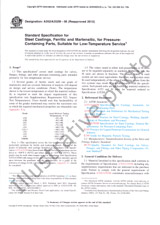We need your consent to use the individual data so that you can see information about your interests, among other things. Click "OK" to give your consent.
ASTM C920-18
Standard Specification for Elastomeric Joint Sealants
Translate name
STANDARD published on 1.1.2018
The information about the standard:
Designation standards: ASTM C920-18
Note: WITHDRAWN
Publication date standards: 1.1.2018
SKU: NS-805028
The number of pages: 4
Approximate weight : 12 g (0.03 lbs)
Country: American technical standard
Category: Technical standards ASTM
The category - similar standards:
Annotation of standard text ASTM C920-18 :
Keywords:
continuous immersion, elastomeric sealants, joint sealants, sealants, specification ,, ICS Number Code 91.100.50 (Binders. Sealing materials)
Additional information
| Significance and Use | ||||||||||||||||||||||||||
|
7.1 This specification covers several classifications of sealants as described in Section 4 for various applications. It should be recognized by the purchaser or design professional that not all sealants meeting this specification are suitable for all applications and all substrates. It is essential, therefore, that the applicable type, grade, class, and use be specified so that the proper classification of sealant is provided for the intended use. Test methods relate to special standard specimen substrates of mortar, glass, and aluminum. If tests are required using substrates in addition to or other than the standard, they should be so specified for testing. |
||||||||||||||||||||||||||
| 1. Scope | ||||||||||||||||||||||||||
|
1.1 This ASTM specification covers the properties of a cured single- or multicomponent cold-applied elastomeric joint sealant for sealing, caulking, or glazing operations on buildings, plazas, and decks for vehicular or pedestrian use, and types of construction other than highway and airfield pavements and bridges. 1.2 A sealant meeting the requirements of this specification shall be designated by the manufacturer to be one or more of the types, classes, grades, and uses defined in Section 7. 1.3 The values stated in SI units are to be regarded as the standard. The values given in parentheses are for information only. 1.4 This standard is similar, but not identical, to ISO 11600 and ISO 11618. 1.5 This international standard was developed in accordance with internationally recognized principles on standardization established in the Decision on Principles for the Development of International Standards, Guides and Recommendations issued by the World Trade Organization Technical Barriers to Trade (TBT) Committee. |
||||||||||||||||||||||||||
| 2. Referenced Documents | ||||||||||||||||||||||||||
|
We recommend:
Technical standards updating
Do you want to make sure you use only the valid technical standards?
We can offer you a solution which will provide you a monthly overview concerning the updating of standards which you use.
Would you like to know more? Look at this page.




 Cookies
Cookies
